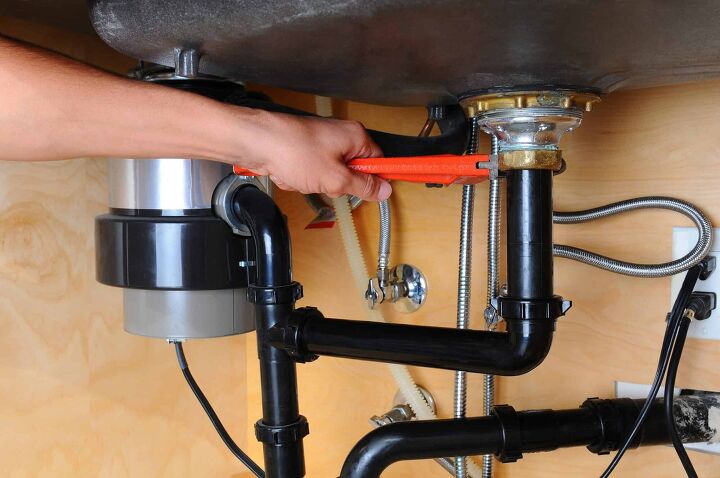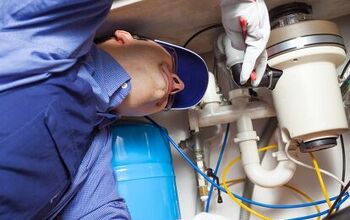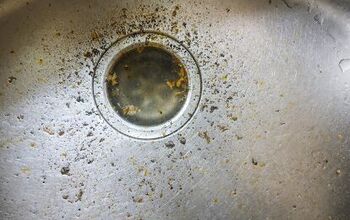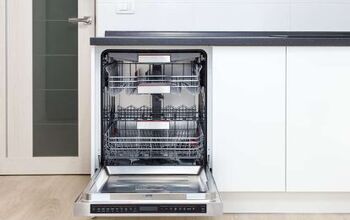How To Cap Off Dishwasher Drain on Garbage Disposal

If you’ve removed, or recently replaced your dishwasher, you may be looking for a solution to plug the hole in your garbage disposal. There is often a drainage line in place that goes from the dishwasher to the garbage disposal.
When the dishwasher is no longer installed, you essentially have a hole in your disposal. While this isn’t necessarily a major concern, it can cause problems when the garbage disposal is in use or when it gets backed up.
To cap off the dishwasher drain on the garbage disposal push a ¾-inch conical rubber plug into the drain hole. Turn off and drain the garbage disposal and dishwasher and remove the dishwasher hose. Push the smaller side of the plug (you can purchase from Home Depot) into the hole, tapping with a hammer if necessary.
It’s a very simple process and you’ll have effectively reduced the risk of any leaks from occurring underneath your sink. Let’s explore this topic in further detail and examine some other common issues that can arise from your dishwasher and garbage disposal system.
Do You Need to Hire a Plumber?
Get free, zero-commitment quotes from pro contractors near you.

What Is A Knockout Plug?
All garbage disposals will come equipped with a knockout plug that is housed inside of the unit. When your garbage disposal has one in place, you likely won’t have any leaking problems but your dishwasher may be not be draining properly.
If you’ve recently installed a new dishwasher and it’s not draining correctly, the culprit may be the knockout plug. They are, just as the name implies, designed to be knocked out. However, you only want to do this if you are connecting the disposal to a dishwasher.
However, if you do not have a dishwasher, you need to make sure that the knockout plug is still in place to prevent any leaks from occurring under the sink. If your dishwasher was recently removed, it most likely will not have the knockout plug inside the disposal anymore. In this case, you cannot replace it. Instead, you’ll have to cap it off from the outside.
Capping Off Your Garbage Disposal
Since you cannot physically replace the knockout plug in the inside of the garbage disposal, you need to plug the drainage hole. While most home improvement stores do not sell rubber caps specifically made for this, you can find similar materials that will fit the hole.
What you need to find is a rubber cap that is a 7/8” ID size and a worm drive stainless clamp. These clamps are often referred to as radiator clamps and can generally be purchased at automotive stores. This device will help to hold the rubber cap securely in place.
If you cannot find either of these, a 7/8” rubber chair leg tip can be used as an excellent alternative and is readily available in the hardware department of home improvement stores. For the clamp, you can use a plumbing clamp, also found at most home improvement stores.
While you can simply tap the cap into the hole to prevent leaks, the addition of the clamp will help hold it in place should any extensive pressure be placed on it. For example, if you ever need to use a plunger to correct a clogging problem, this will displace the plug and cause water to shoot out of the hole.
An Additional Method For Closing Off Your Dishwasher Drain Hole
Most dishwashers are connected to the garbage disposal through an inlet valve. This is what transfers dirty water out of your dishwasher and then out of your home. If you’re removing your dishwasher and it was previously connected to your garbage disposal, you need to close off the drain hole to allow you to use your sink.
If it’s not closed off, you’ll have water leaking under your sink, which could damage the items you are storing or the flooring beneath the cabinet. To ensure that you don’t have water spilling out of the open valve after the drain line is removed, you need to cap off the end of the inlet.
Follow the below steps for another method of capping off this drain. This can be done right after you’ve removed your dishwasher:
- Clear the area under the kitchen sink so you can easily access the garbage disposal. Put a bucket underneath where the dishwasher attaches to the drain on the disposal.
- Remove the dishwasher drainage hose. Do this by undoing the clamp and pulling the hose away from the barbed fitting.
- Place the hose into the bucket to drain.
- Taking a dishwasher drain connector, loosen the clamps on both sides. Push the open end of a ½ inch copper pipe cap fitting into the small side of the drain connector.
- Tighten the clamp to fasten the pipe cap into the connector.
- Slide the open end of the dishwasher connector into the barbed fitting on the drain line or disposer.
- Tighten the clamp to secure.
- Flush water through the drain to check for leaks.
How To Remove The Knockout Plug
Another common issue with the dishwasher and garbage disposal is a dishwasher that is not hooked up properly, and has drainage problems. In this instance, you likely just recently installed a new dishwasher and a small detail was overlooked.
Your dishwasher needs to be hooked up to the garbage disposal in order to drain successfully. To do this, you should remove the knockout plug from inside your garbage disposal and install the dishwasher drainage tube.
In order to remove the knockout plug, you need a hammer and a screwdriver. Locate the plug by poking into the drainage hole on your garbage disposal. If it inserts easily, the drainage plug has already been removed and the drainage problems are not caused by the knockout plug.
However, if the screwdriver hits something solid, this is the knockout plug. Use the hammer to lightly tap the back of the screwdriver around the perimeter of the plug until it falls into the disposal unit. Use your hand or pliers to reach down through the sink opening to retrieve and remove the plug.
With the knockout plug detached, you can tightly affix the drainage tubing for the dishwasher and successfully thwart your drainage issues.
Hooking Up a Dishwasher Without a Garbage Disposal
While it’s most common for your dishwasher to be hooked up to garbage disposal for drainage, what happens if you don’t have one? In this case, the dishwasher drain will be indirectly tied to the sink drain by using an air gap or it can be connected by the high-loop method, directly to the drain.
Drain Connection with Air Gap
For this method, when there is no garbage disposal, the dishwasher drain will be connected by using an air gap. An air gap fitting is a safety mechanism that is affixed on your sink or countertop, where the dishwasher hose passes on its way to the drain. It offers a pressure break in the drain line that prevents the likelihood of dirty drain water from filtering back into a dishwasher with clean dishes.
First, connect the drainage hose to the small end of the air gap. After it’s in place, use a 7/8-inch rubber hose to place the larger end of the air gap onto the skin drain’s Y-branch tailpiece. Using hose clamps, attach both ends of the drainage hose to their tailpieces. Make sure that you have no kinks in the tubing before clamping the hose in place.
Drain Connection High Loop Method
This option uses the high-loop method instead of an air gap fitting. Make sure that your local building code allows for this specific installation. Implementing a high loop is also effective at preventing backflow contamination in your dishwasher.
To connect the dishwasher drain using the high loop method, you’ll need to pull as much drain hose slack as possible, loop it as high as it will go under the sink and secure in place. Using the end of the dishwasher drain line, connect it to the Y-branch tailpiece and secure it with a hose clamp.
Although most dishwashers come from the manufacturer with the drain looped high along the side of the machine, this does not serve as a substitute for the high loop under the sink.
Do You Need to Hire a Plumber?
Get free, zero-commitment quotes from pro contractors near you.

Related Questions
Why won’t my dishwasher drain?
There are a couple of possible reasons why your dishwasher may not be draining. First, if you recently installed or replaced the dishwasher, the knockout plug may still be in place. If this plastic plug inside of the garbage disposal is not popped out, your dishwasher won’t drain and water will pool inside of the appliance. If this is not the case, the air gap or garbage disposal might be clogged, or the dishwasher may simply be too old and need replacing.
Why is my garbage disposal leaking from the bottom?
Although leaks from the drainage port can often be easily corrected, leaks from the bottom of the unit are more complicated. Leaking water from the base of the garbage disposal (often the reset button), usually means that a seal on the interior shell has become damaged or the shell itself is cracked. In this case, to correct the leaking, you’ll need to replace the entire unit.
Related Guides

Real estate agent and copywriter, originally from California. Chloe brings her real estate expertise into her writing to create effective and helpful home guides for you! When not writing or selling homes, she spends her time as a digital nomad traveling the world.
More by Chloe Meltzer



























